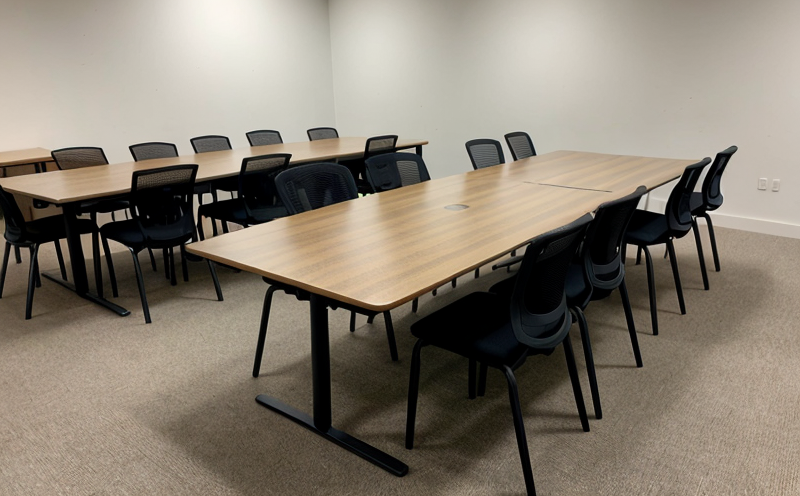ISO 7173 Furniture Chairs and Tables Determination of Stability Testing
The ISO 7173 standard is designed to ensure that furniture, particularly chairs and tables, can withstand the forces applied during normal use without tipping over or becoming unstable. This test is crucial for manufacturers, quality managers, compliance officers, and R&D engineers who need to guarantee product safety and durability.
Furniture stability is a critical factor in maintaining user safety and satisfaction. An unstable chair or table can lead to accidents, injuries, and even damage to the furniture itself. The ISO 7173 standard provides a standardized method for testing the stability of these items under specific conditions that simulate real-world use.
The test involves placing a specified load on the furniture and assessing its response. For tables and desks, this typically includes applying a force at various points to determine if any part of the structure will tip or collapse. The standard specifies the minimum number of tests required for different types of furniture based on size and intended use.
The testing process begins with careful preparation of the specimen. This involves selecting the appropriate type and size of table or desk, ensuring it is free from defects, and assembling any necessary components according to manufacturer specifications. Once prepared, the specimen is placed on a flat surface suitable for the test conditions.
During the test, forces are applied in accordance with the standard's requirements. For tables and desks, this might include placing weights at specific points or using specialized equipment to simulate user interaction. The test apparatus used can vary depending on the type of furniture being tested but typically includes precision scales and calibrated force application tools.
The results of these tests are meticulously recorded and analyzed to ensure compliance with ISO 7173 requirements. Compliance officers must review these reports to confirm that all aspects of the testing process meet the specified criteria. Engineers responsible for R&D can use this information to refine designs or identify areas for improvement.
For procurement teams, ensuring adherence to standards like ISO 7173 helps in selecting high-quality materials and components. By choosing suppliers who already adhere to these standards, organizations reduce risks associated with substandard products entering the supply chain.
The importance of this testing cannot be overstated. It plays a vital role in maintaining user safety while also protecting brand reputation and compliance with regulatory requirements. Manufacturers who invest in thorough stability testing not only enhance their product quality but also demonstrate commitment to customer satisfaction and safety standards.
Applied Standards
| Standard | Description |
|---|---|
| ISO 7173 | Determination of Stability for Furniture Chairs and Tables |
| ASTM F1554 | Safety Specification for Recreational, Conditioning, and Athletic Equipment |
| EN 60328-1 | General Requirements for Household Appliances - Part 1: General Safety Requirements |
Why Choose This Test
The ISO 7173 stability test is essential for manufacturers looking to ensure their furniture meets the highest safety and quality standards. By choosing this test, companies can demonstrate their commitment to user safety and compliance with international regulations.
This testing method allows organizations to identify potential weaknesses in design or construction early in the development process. Engineers have the opportunity to make necessary adjustments before production begins, reducing costly rework later on. For quality managers involved in certification processes, passing this test is often a prerequisite for obtaining important certifications and labels that enhance brand reputation.
Compliance officers benefit from consistent data across different manufacturers because they can rely on standardized testing methods when evaluating products against relevant standards. This uniformity helps streamline the auditing process and ensures compliance with local laws and international norms.
R&D engineers find value in this test as it provides valuable insights into how various materials and structures perform under stress conditions similar to those experienced during actual use. This information can be used to innovate new designs or improve existing ones, leading to more robust products that last longer without compromising on aesthetics.
For procurement teams, selecting suppliers who have already passed this test ensures consistency in quality across all sourced components and finished goods. It helps build trust within the supply chain and reduces risks associated with purchasing potentially defective parts.
In summary, choosing to conduct ISO 7173 stability tests offers numerous advantages for businesses operating in the furniture industry. From enhancing product safety to streamlining regulatory compliance processes, this testing method is indispensable for maintaining high standards throughout production cycles.
Competitive Advantage and Market Impact
Adopting ISO 7173 stability testing provides significant competitive advantages in the furniture market. By ensuring that products meet or exceed international safety standards, manufacturers can differentiate themselves from competitors who may not adhere to such stringent criteria.
Consumers are increasingly becoming more aware of product quality and safety issues. Those companies that invest in rigorous testing like ISO 7173 tend to gain a positive reputation among consumers, leading to increased customer loyalty and potentially higher sales volumes. This enhanced image can also attract new customers seeking reliable products.
In addition to improved brand perception, passing these tests can open up access to international markets where strict compliance with safety regulations is required for entry. Certification from recognized bodies such as SGS or TÜV adds credibility to a company's offerings and increases its chances of winning contracts in competitive bidding processes.
From an operational perspective, implementing ISO 7173 stability testing helps reduce the likelihood of recalls due to design flaws or manufacturing defects. Such incidents can be costly both financially and reputationally. By proactively addressing these issues through thorough testing early on in development stages, companies minimize disruptions caused by post-production problems.
The long-term benefits extend beyond immediate financial gains; they encompass building sustainable relationships with stakeholders including employees, suppliers, customers, and regulators. A reputation for producing safe and reliable furniture fosters trust within the industry ecosystem, creating a virtuous cycle of growth and innovation.





